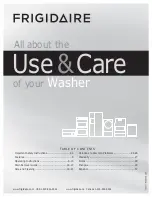
Loading the dishwasher
Greener dishwashing
Do not rinse under running water
Simply scrape off large food particles before loading the dishwasher.
Choose a green detergent
Read the environmental declaration on the packaging!
Run programs only with a full load
Wait until the dishwasher is fully loaded before running a program, this
way you save energy. Use the Rinse and hold program to rinse the
dishes if there are any unpleasant odors while you wait for the
dishwasher to become fully loaded.
Run programs at a lower temperature
If the dishes are only lightly soiled, you can select a program with a
low temperature.
Select ECO wash
This program is the most effective in terms of energy consumption.
Select Green mode
The dishwasher has different program modes. To save energy and
water, use Green mode. (Available with: Normal wash, Sanitation wash)
Open the door a little once the program has finished
Better drying results are achieved if you open the door a little once the
program has ended. (If the dishwasher is built-in, the surrounding
furnishings must be resistant to any condensation from the dishwasher.)
Connect to cold water
Connect the dishwasher to the cold water supply if the building is
heated using oil, electricity, or gas.
Connection to hot water supply
Connect the dishwasher to the hot water supply (max. 160 °F (70 °C))
if the building is heated using an energy-efficient means such as district
heating, solar power, or geothermal power. Choosing a hot water
connection cuts dishwashing times and reduces the dishwasher's
energy consumption.
NOTE!
Do not exceed the permitted water supply temperature. Certain
materials used in some cookware cannot withstand strong heat.
Fragile dishes
Some cookware is not dishwasher safe. This can be for several reasons.
Some materials cannot withstand high temperatures, others can be
damaged by dishwasher detergent.
Use caution with, for example, handmade items, fragile decoration,
crystal/glassware, silver, copper, tin, aluminum, wood, and plastic.
Look for the "Dishwasher safe" marking.
Fragile decoration
Porcelain with decoration on top of the glazing (the items feel rough)
should not be washed in a dishwasher.
Crystal/Glass
Wash fragile items made of crystal/glass, such as crystal glass from
Orrefors, using the gentle dishwashing program Crystal glass.
Remember to use a small amount of detergent and to place items so
that they do not touch each other during the wash.
Use rinse aid to improve wash and dry times. Also use rinse aid to
achieve clear and spotless results.
Hand-painted glassware, as well as antique and very fragile items,
should not be washed in a dishwasher.
Silver
Silver and stainless steel items should not come into contact, as the
silver can become discolored.
Aluminum
Aluminum can lose its shine if washed in a dishwasher. However, good
quality aluminum pans can be washed in a dishwasher, even if some
of the shine will be lost.
Cutlery with glued handles
Some types of glue are not dishwasher safe. In such cases, the handles
may loosen.
Points to consider
• All dirty surfaces should face in and down!
• Dishes should not be placed in or on each other.
• Angle dishes with hollows, such as cups, so that the rinse water
will run off. This is also important for plastic items.
• Place the upper basket in its highest position when dishwashing
very large plates.
• Make sure small items cannot fall through the dishwasher basket;
place them in the cutlery basket.
NOTE!
Check that the spray arms can rotate freely.
5
Summary of Contents for DBI675 XXLS
Page 1: ...Dishwasher DBI675 XXLS OPERATING INSTRUCTIONS EN...
Page 25: ...Notes 25...
Page 26: ...Notes 26...
Page 27: ...Notes 27...






































